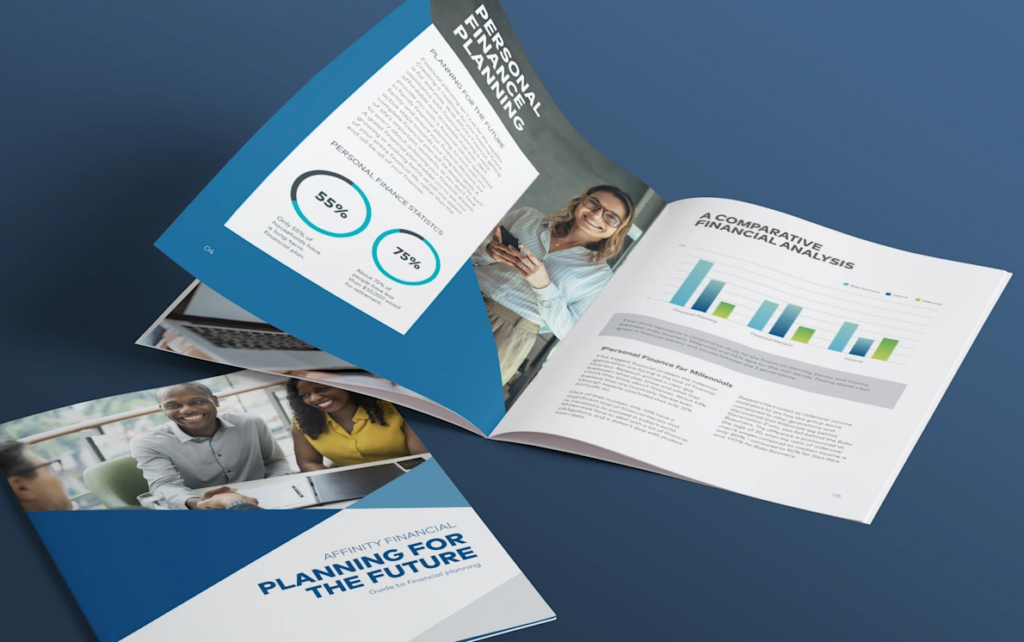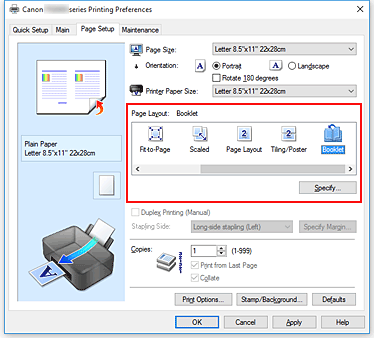Enhancing Trade Show Success with Strategic Booklet Printing
Enhancing Trade Show Success with Strategic Booklet Printing
Blog Article
The Vital Guide to Understanding Brochure Printing Options and Techniques
The procedure of booklet printing includes multiple considerations that can considerably influence the end product. From picking the appropriate format and size to recognizing the nuances of binding techniques, each option plays an important function. Furthermore, elements such as paper supply and printing methods further influence the efficiency of the pamphlet. As one browses these alternatives, it ends up being necessary to realize how they interconnect and what that indicates for the total end result.
Comprehending Pamphlet Sizes and layouts
When taking into consideration pamphlet printing, understanding the various layouts and sizes available is important for achieving the desired presentation. Brochures can be created in numerous layouts, including saddle-stitched, spiral-bound, and perfect-bound, each offering distinctive advantages. Usual sizes vary from conventional letter (8.5 x 11 inches) to smaller sized choices like A5 (5.8 x 8.3 inches), permitting for flexibility based upon material and target audience.Selecting the appropriate dimension can influence both the format and reader interaction. Larger sizes may match aesthetically driven content, while smaller sized styles may be extra portable and user-friendly. Additionally, the variety of web pages influences the choice of binding approach, as thicker pamphlets may call for sturdier bindings. Ultimately, understanding these elements allows for a more tailored strategy, ensuring that the final product straightens with the desired message and aesthetic, boosting the total effectiveness of the interaction.
Selecting the Right Paper Supply

Binding Approaches: Options and Factors To Consider
When it comes to binding methods for pamphlets, a number of alternatives are available, each with distinct benefits. Saddle stitch binding offers an economical option for thinner pamphlets, while perfect binding techniques supply a more sleek appearance for thicker publications. Wire-O binding stands apart for its longevity and ease of usage, making it excellent for files that require versatility.
Saddle Stitch Binding
Saddle stitch binding offers a cost-effective and practical option for assembling pamphlets, making it a popular choice among businesses and publishers. This binding method includes folding sheets of paper in fifty percent and stapling them along the fold line, producing a neat and orderly appearance. Typically ideal for brochures with a reduced page count, saddle sewing is ideal for publications, sales brochures, and training products. The simplicity of this strategy allows for quick manufacturing and is often favored for brief runs or marketing products. However, it is vital to keep in mind that saddle stitch binding may not appropriate for thicker booklets, as the spine may not hold up under increased weight. On the whole, it remains a reliable alternative for many printing jobs.
Perfect Binding Strategies
Perfect binding is an extensively utilized technique that supplies a sleek and specialist finish to pamphlets and publications. This technique entails gluing the pages with each other at the back making use of a solid adhesive, enabling a clean edge and the capability to hold a larger variety of web pages contrasted to saddle stitching. Perfect binding is specifically ideal for thicker brochures, such as magazines and yearly records, where a strong, flat spinal column is wanted. In addition, it offers the option for a printed cover that can be made to improve aesthetic appeal. Nonetheless, considerations such as page count, paper weight, and the planned use the booklet ought to be considered, as they can influence durability and total quality.
Wire-O Binding Alternatives
Wire-O binding, known for its toughness and flexibility, uses a superb alternative for brochures that call for simple web page transforming and a professional look. This binding technique utilizes a series of metal loops that hold web pages securely, enabling them to lie flat when open. It is particularly ideal for presentations, handbooks, and directories due to its robust nature. Wire-O binding is readily available in different shades and sizes, fitting different page matters and densities. Furthermore, it permits the inclusion of tabs and covers, improving the booklet's overall visual. Considerations for Wire-O binding consist of the selection of cable shade, the size of the loops, and the degree of customization preferred, all of which can profoundly influence the end product's look and performance.
Digital vs. Offset Printing: Which Is Best for You?
When picking a printing approach for booklets, comprehending the distinctions between electronic and balance out printing is essential. Digital printing utilizes modern innovation to create premium prints promptly and affordably, making it ideal for short runs or jobs needing quick turn-around times. It allows for customization, supplying the capacity to print on-demand with marginal waste.In comparison, offset printing is a typical method that excels in producing big amounts with consistent high quality. It entails moving ink from a plate to a rubber covering, after that to the paper, which leads to vibrant colors and exact details. Balance out printing commonly needs longer configuration times and is extra economical for bigger volumes.Ultimately, the selection in between digital and offset printing depends on job needs, budget, and desired amount. For tiny, time-sensitive jobs, digital could be the very best selection, while offset might be better for larger, top notch manufacturings.

Designing Your Brochure: Tips and Ideal Practices
When developing a pamphlet, careful attention to design, font selection, and color use can greatly enhance its performance. A well-structured design guides the reader's eye, while suitable typefaces ensure readability and communicate the desired tone. Additionally, effective use shade can stimulate emotions and highlight crucial info, making the general style a lot more impactful.
Selecting the Right Design
Just how can one effectively pick the ideal format for a pamphlet? It is important to review the brochure's purpose and target audience. A tidy, organized design enhances readability and involvement. Utilizing a grid system can assist in aligning elements constantly, developing a specialist look. In addition, including aesthetic power structure through differing dimensions and positionings of pictures and message can lead the visitor's eye and emphasize key information. It is also vital to leave adequate white room, which stops congestion and permits better emphasis. Evaluating various designs with mock-ups can offer understanding into just how the style executes in real-world scenarios, guaranteeing that the last product satisfies both aesthetic and useful demands. Practical Choosing Ideal Typefaces
A well-chosen font can substantially enhance the general style of a brochure, enhancing the layout and reinforcing the material's message. The choice of fonts should consider readability, especially for body text, as it assures the information is More Info easily accessible to all readers. Sans-serif fonts are usually chosen for electronic formats, while serif fonts can provide a standard feel in published materials. It's recommended to limit font options to 2 or 3 to preserve aesthetic coherence. In addition, font style dimension plays an essential duty; headings ought to be distinct but not overwhelming, while body text must be comfy for analysis. When picking font styles, alignment with the booklet's style and target market is important for efficient interaction and aesthetic appeal.
Effective Use of Shade
Shade works as a powerful tool in pamphlet design, leading and forming perceptions reader feelings. It can evoke sensations of excitement, trust fund, or calmness, relying on the shades picked. Designers ought to think about shade theory principles, making certain that the selected combination straightens with the brochure's message and target audience. As an example, utilizing cozy colors like red and orange can develop seriousness, while cooler tones like green and blue foster tranquility.Additionally, contrast plays an important function; corresponding colors can boost readability and aesthetic allure. Consistency in shade use this website across pages even more enhances brand identity and communication. Eventually, effective color application not only catches interest however also reinforces the brochure's function, making it an essential aspect of successful design.
Ending Up Touches: Coatings and Special Results
While several consider the material and format of a pamphlet the most critical elements, the ending up touches, such as coverings and unique effects, play an essential function in improving its overall charm. Coatings can provide defense and toughness, making certain that the booklet stands up to damage. Matte finishes supply an innovative, non-reflective surface, while shiny layers can make colors appear even more appealing and vibrant. Unique impacts, like embossing or foil stamping, add a responsive dimension that can develop a memorable impact. These strategies can highlight particular locations, accentuating important details or producing visual interest. In addition, UV finish can supply a high-shine finish that boosts the total look.Together, these finishing touches not just boost the booklet's visual yet also connect professionalism and reliability and focus to detail, ultimately leaving a long-term influence on the viewers.
Cost Factors To Consider for Pamphlet Printing
Understanding the various price factors to consider for booklet printing is important for companies and services intending to optimize their spending plans. Key variables affecting prices include the option of paper, binding, and ink approaches. go to this site Greater top quality products, such as premium paper or specialized inks, commonly increase the total cost. Additionally, the size and web page matter of the pamphlet play a significant role; larger brochures call for more sources and time to produce.Another important factor to consider is the printing strategy, whether digital or balanced out, as each has its very own pricing structure and viability for different amounts. Services need to also consider layout costs, which can differ based on intricacy and using expert solutions. Eventually, delivery and handling fees can add to the overall, particularly for large orders. By reviewing these elements, organizations can make enlightened choices that align with their financial capabilities while accomplishing the desired top quality in their printed products.
Regularly Asked Concerns
What Are the Environmental Influences of Brochure Printing?
The ecological influences of pamphlet printing consist of logging from paper manufacturing, carbon emissions from transportation, and waste generation from discarded products - Booklet Printing. Sustainable methods, such as using recycled paper and environment-friendly inks, can alleviate these effects
How Can I Guarantee Color Accuracy in My Pamphlet?
To assure color accuracy in a pamphlet, one ought to make use of calibrated monitors, use professional color accounts, carry out test prints, and pick high-quality printing services that use shade matching and proofing choices for best results.
What Is the Common Turn-around Time for Brochure Printing?
The common turn-around time for brochure printing varies depending upon the intricacy and amount - Booklet Printing. Usually, it ranges from a couple of days to 2 weeks, affected by aspects such as publishing techniques and ending up requirements
Exist Minimum Order Quantities for Brochure Printing?

Can I Print Booklets in Numerous Languages?
Printing pamphlets in numerous languages is feasible. Several printing solutions provide options for multilingual or multilingual formats, allowing for reliable communication. Cautious preparation warranties that create aspects fit different languages without endangering readability or aesthetics. Furthermore, elements such as paper stock and printing methods more affect the performance of the pamphlet. When taking into consideration pamphlet printing, comprehending the different formats and sizes readily available is important for achieving the desired discussion. When choosing a printing approach for brochures, comprehending the differences between electronic and counter printing is essential. Furthermore, the size and web page count of the pamphlet play a considerable duty; larger pamphlets need even more resources and time to produce.Another crucial consideration is the printing technique, whether digital or countered, as each has its very own rates structure and suitability for different amounts. The ecological influences of pamphlet printing include logging from paper manufacturing, carbon discharges from transportation, and waste generation from discarded products.
Report this page